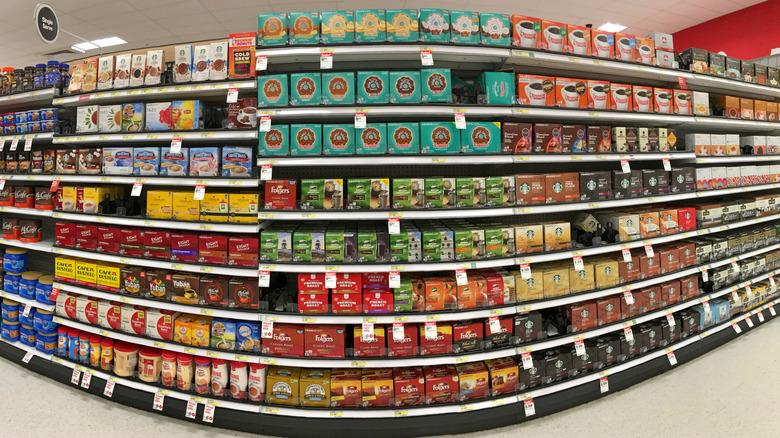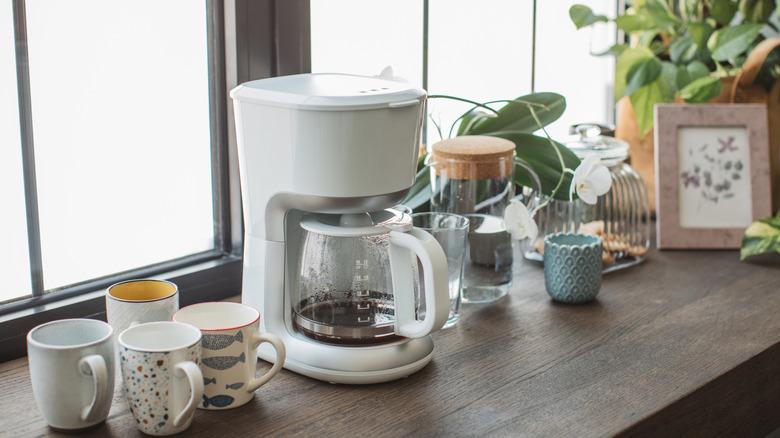Why You May Want To Think Twice Before Grabbing A Keurig For Your Home
Keurig coffee makers are certainly convenient, but they are not cheap, fresh, or environmentally friendly. More than a quarter of Americans use single-serving coffee brewing machines, with Keurig being the most popular brand. Before you go out and buy your own Keurig (or more K-Cups for your existing Keurig), consider the cost — to your wallet, your taste buds, and the environment. There are cheaper, greener, and fresher ways to get your morning cup of Joe. Just ask John Sylvan, the co-inventor of the K-Cup in the 1990s. He doesn't even use a Keurig coffee maker. "I don't know why people have them in their house," he told the Canadian Broadcasting Corporation (CBC).
One reason Sylvan doesn't use a Keurig: "I find them rather expensive." You can order unflavored K-Cup pods from the Keurig website at roughly 75 cents a pod – more than twice as much as it cost just a decade earlier. Branded and flavored coffees are around $1.00 a pod. You'd be hard pressed to find a $1.00 cup of coffee at any coffee shop in the United States. Still, that's far more expensive than if you bought your own ground coffee and brewed it yourself (not to mention the cost of a Keurig single cup coffee maker). Buy an 88-pod pack of Starbucks Vanilla Lavender ground coffee from Keurig and you'll spend over $80. With a typical K-cup containing 9 to 12 grams of coffee, that amounts to paying roughly $43 to purchase a pound of coffee. You can buy the same Starbucks Vanilla Lavender ground coffee at Target for around $15 per pound.
The Environmental Cost of Keurig K-Cups
John Sylvan hoped the K-Cup would reduce the number of Starbucks and Dunkin coffee cups ending up in the landfill, only to watch his invention become its own environmental nuisance. With an estimated 50 to 60 million coffee pods used each day, most enter the waste stream, even if "K-Cup® pods are made from recyclable material," as the manufacturer claims. A little footnote qualifies that statement, noting that its pods are "not recyclable in many communities." And therein lies the problem. After years of making their K-Cups entirely from unrecyclable plastic, Keurig switched in 2020 to primarily plant-based materials sealed with a layer of polypropylene, the number 5 plastic used to lock in freshness. Polypropylene is indeed recyclable, but only 1 to 3% of it actually is recycled, due to the complexity of the process of recycling number 5 plastic.
Since they are labeled as recyclable, consumers are tempted to just toss their K-Cup pods into a blue bin and feel they've done the right thing. Yet it takes effort to figure out whether or not your own community's recycling facility can process them. If it can't, then it sends the pods to the landfill, adding to the center's processing and shipping costs. In the landfill, it can take centuries for polypropylene to decompose, taking up valuable space and potentially contributing to environmental pollution.
Alternatives to Keurig K-Cups
Sure, single-serve coffee makers are convenient, but there are ways to create your own at-home coffee station that are more sustainable, lower in cost, and create a fresher, crisper cup of coffee with no more effort than it takes to use, regularly clean, and periodically troubleshoot a Keurig. As John Sylvan told the CBC: "it's not like drip coffee is tough to make." Simple drip coffee makers and filters made from metal, cloth, or recycled paper are more sustainable options and less expensive than a Keurig machine and its pricey pods. Add in a reusable bamboo coffee scoop and a glass mason jar for storing your shop-ground beans, and you're likely still coming out ahead financially while making sustainable choices. Using a stainless steel espresso maker or a glass French press means you also don't have to worry about trying to remove a plastic taste from your Keurig. Get a coffee maker with a timer, and your coffee can be ready for you in the morning.
If you already own a Keurig machine, don't throw it away just to buy a drip coffee maker, though. There are ways you can be a more responsible Keurig owner, by recycling or reusing your pods. Turn them into musical shaker toys for children by filling them with rice and taping them closed. Or, use them as scoops for gardening, pots for watercolor paints, or takeaway containers for dressings and sauces.


